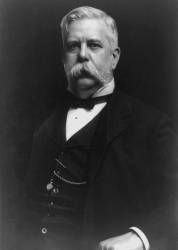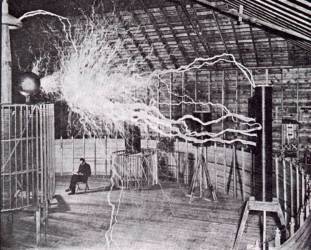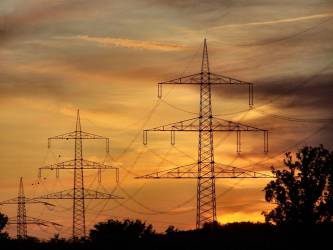At the end of the 19th century, humanity captured power in its highest form: electricity. With a new magical power in the hands of great industrialists, a battle for ownership of the multi-million dollar future of its technological development ensued. The great engineer George Westinghouse dared do battle with Thomas Edison–fellow engineer and brilliant inventor–in a terribly sinister public relations clash over economic dominance. This “War of Currents” centered on the most base of human emotions: fear. It was so fantastic and unbelievable that it was even recently featured in the popular movie, “The Prestige.”
Let There Be Light!
The beginning of the 20th century saw a particularly amazing change in the human condition thanks to the ingenuity of engineers. Light, which had once regularly disappeared with the setting sun, was now shining late into the night, allowing humanity to squeeze a few extra hours of productivity into each day. Small, glowing orbs called incandescent bulbs were working with newly developed distribution networks to produce a vibrant light that would change our world.
However, this was not a happy, magical new world for everyone. Electric power was creating a new, rapidly expanding market, with millions of dollars up for grabs. Two great engineers, Thomas Edison and George Westinghouse, had two very different ideas about how to deliver electric power to the masses (see Fig. 1). The political and economic climate in the late 1800s was quite cutthroat, inducing a standards war like none other. These two engineers went to great lengths, from brutal animal experimentation to the invention of the electric chair, to ensure dominance for their own respective technologies. Only one, however, could prevail.

Wikimedia Commons
Figure 1: Thomas Edison.
Thomas Alva Edison
Born February 11, 1847, Thomas Edison had a curious manner. He asked too many questions in school, which lead teachers to consider him less intelligent than most children [1]. Later in life, he became a telegraph operator, where he became enthralled with the power of electricity. He eventually collected enough money to leave day jobs behind and work as a full time inventor. Among the astounding 1,093 patents to his name, one that stands out is the ‘Carbon Filament Lamp’, more commonly known as the first practical light bulb. This invention left the gas companies reeling and Edison started the Edison Electric Company to capitalize on his new market. Edison enjoyed a short period of complete dominance over the market, supplying customers with Direct Current (DC) electric power for his new bulbs. However, a menace called Alternating Current (AC) was beginning to threaten his newly devised distribution network [2].

Joseph G. Gessford/Wikimedia Commons
Figure 2: George Westinghouse.
Westinghouse and Tesla
Enter the young entrepreneur/inventor George Westinghouse, born just months before Edison on October 6, 1846 (see Fig. 2). Like Edison, this future titan of industry did poorly in school at a young age. However, he soon made up for early academic flaws by devising the airbrake used on railroads in 1869 [3]. This invention dramatically reduced the stopping distance required by locomotives, allowing them to both haul heavier loads and carry passengers more safely. While Westinghouse was an inventor in his own right, he also excelled at bringing ideas together and cutting deals for profit. This entrepreneurial spirit watched the rise of electric power with an eager interest. Westinghouse wanted to get in on the industry, but he needed a way around Edison’s hundreds of patents monopolizing DC power distribution.
AC power was the answer to Westinghouse’s problem, but it was an incomplete power system. No efficient electric motor had been devised for AC, whereas hundreds had been developed for the more prevalent DC system. However, the stars aligned for Westinghouse when a young electrical engineer named Nikola Tesla showed up on his doorstep (see Fig. 3). Tesla had conceived of an electric motor that would run on AC with no moving parts. At the time, this concept was considered a physical impossibility by the scientific community, a sort of perpetual motion machine. Tesla, in his genius, devised the entire system in a flash of insight while watching a sunset in Prague. Many years later, Tesla, with the design completed only in his mind, convinced Westinghouse of the feasibility of his idea. With this pairing, the AC system was complete. AC was more efficient and practical than DC, but wholly untested. And Edison stood directly in its path toward public acceptance and market dominance .

Yelm/Wikimedia Commons
Figure 3: Nikola Tesla in his laboratory in Colorado.
AC/DC
The primary difference between DC and AC is their respective symmetries. DC is simple and easy to visualize as a flow of water through a pipe, only the water is actually electrons. It comes in through one line, is used, and heads back through another. On the other hand, AC is a more complex but beautifully symmetric approach, made by alternating the voltage in sinusoidal waves, like the rolling waves of the ocean. By alternating and offsetting the potential, constant power is delivered much like how peddling a bicycle delivers constant power, even though only one leg is ever pushing at a time, allowing the other to recover. The same amount of power is delivered with either approach, but distribution is more efficient with AC because its symmetry allows it to be easily elevated to a higher voltage, which can then traverse great distances without losing much power. DC, on the other hand, could not be easily elevated or lowered, making it impossible to go more than a few blocks without needing a new generator.
First Blood
Westinghouse began making serious gains in the industrial market since cheaper distribution for AC power led to lower prices. Edison was aware of the rising menace and openly slandered AC power, proclaiming that AC entailed “greatly enhanced risks to life and property” due to its high transmission voltages [2].
Another player by the name of Harold Brown entered onto the stage with the goal of annihilating AC’s credibility. His business relied on the popularity of the arc lighting system that depended on DC power to operate. He did not want to see DC out-maneuvered by Westinghouse’s ingenuity. He declared AC to be a hazard to public safety and tried to get legislation passed to outlaw high voltage lines, aiming to destroy the great advantage that AC had over DC. AC investors protested heavily, stopping the legislation in its tracks. Brown then began a public relations campaign to destroy the AC distribution system. Edison never made any official ties with Brown, though he gave Brown unlimited use of his advanced West Orange Laboratory and supplied him with any machinery and personnel necessary [2].
Fear was the chosen tactic, and AC had to look like a killer. Through a series of graphic and cruel animal tests on dogs, cows, and horses, Brown demonstrated the killing power of electricity. Unfortunately for DC supporters, there was no actual data that showed DC was safer than AC. Facts had little weight with the unscrupulous Brown, however, who didn’t follow any sort of scientific procedure during the tests, simply electrocuting most of the animals using AC, then declaring it unsafe. However, with no one understanding even the basics of electricity (the electron had not yet been discovered), Brown’s experiments were still terrifying and convincing, despite being scientifically invalid. AC became widely distrusted and its supporters could do little but publish wordy scientific reports refuting Brown’s results [2].
The Fair
The ultimate test between Edison and Westinghouse came in 1892 with a fair in Chicago commemorating the 400th anniversary of Columbus’s landing. An open contest was held to see who could provide the best power for the fair, which was to feature “Electricity” as its main attraction. Edison seemed to be the clear choice with his proven technology and national reputation. However, at the last minute, Westinghouse undercut his price by half, convincing the officials to go with his AC machines.
Edison could not take a blow like that sitting down, and tried one last desperate measure to defeat Westinghouse. Edison owned the patent for the enclosure of the light bulb we use today that simply screws into a socket and lights up. He went to court and made it illegal for Westinghouse to produce the design, casting the fair into darkness in one vicious stroke. With less than a year to go, Westinghouse gathered all his resources and modified an old two-stage light bulb he held under patent from years ago. The design was much less efficient, but he managed to produce 250,000 of them before the fair, a truly astounding display of industrial might. The fair went on without a hitch, with Tesla and Westinghouse showing the world the power of AC, while Edison set up a small booth showcasing his old light bulb designs. About 27 million people, a quarter of the American population, visited the fair to see Westinghouse’s electric wonderland. With such widespread publicity, the war was over, and Edison experienced one of his few complete failures. His company merged to become General Electric and began producing and distributing the AC system [2] [3].
DC’s Comeback
Edison would probably get a good smirk out of AC power’s progress today. With the modern development of computers and handheld electronics, the old workhorse in the wall seems to be falling behind to its DC brother. Electronics like computers, MP3 players, flashlights, stereos, televisions, DVD players–the list goes on–all use DC. AC power would destroy these electronic devices without plug-in power adapters that make the “deadly” AC safe for your electronics.

Andrea Kratzenberg/SXC
Figure 4: High Voltage AC Transmission Line.
Lighting The World
While DC is the mainstay in the world of consumer electronics, it is still AC that strings our world together. Our entire continent, for instance, is divided into four electric grids. The immense distance traversed by AC power lines is astounding; a light bulb in Los Angeles could be lit by a power plant in Montana [2]. The existence of this system is due largely to the work of Westinghouse and Tesla, two great engineers working together to overthrow the brilliant Thomas Edison. Advanced AC systems distribute the power for the devices that define the modern American home. However, the AC system also has its drawbacks. The great Northeastern Blackout in 1965 was due to the immense interconnectivity of AC networks. It left nearly 30 million people in the dark, all because of the failure of a single transmission relay [2]. One small accident has the capacity to cascade into a catastrophe, leaving millions in the cold dark world that existed before electricity was commonplace.
Technology can stagnate when competition is lagging or crushed altogether. Without the opposition to Edison’s monopoly that came from the Tesla and Westinghouse collaboration, electricity might have remained too expensive and impractical for widespread use. While they have given us such tremendous power, we have also become highly dependent on that silent stream of energy. These great men put this power at our fingertips, lighting the world and ushering in our modern age.
References
-
- [1] R. Clark. (1977). Edison: The Man Who Made the Future.
- “George Westinghouse” [Online]. Available: http://commons.wikimedia.org/wiki/Image:George_Westinghouse.jpg
- [2] T. McNichol. AC/DC: The Savage Tale of the First Standards War 2006, pp. 32-176.
- [3] Q. Skrabec Jr. George Westinghouse: Gentle Genius. 2007.
